Key takeaways:
- Understanding vape supplies and their compatibility is crucial for enhancing the vaping experience.
- Adapting tools and making small modifications, like adjusting wattage or coil types, can significantly elevate user satisfaction.
- Engaging with the vaping community to gather feedback is essential for identifying project requirements and improving product development.
- Customizing tools and seeking user insights during the design process can lead to innovative solutions that resonate with consumers.
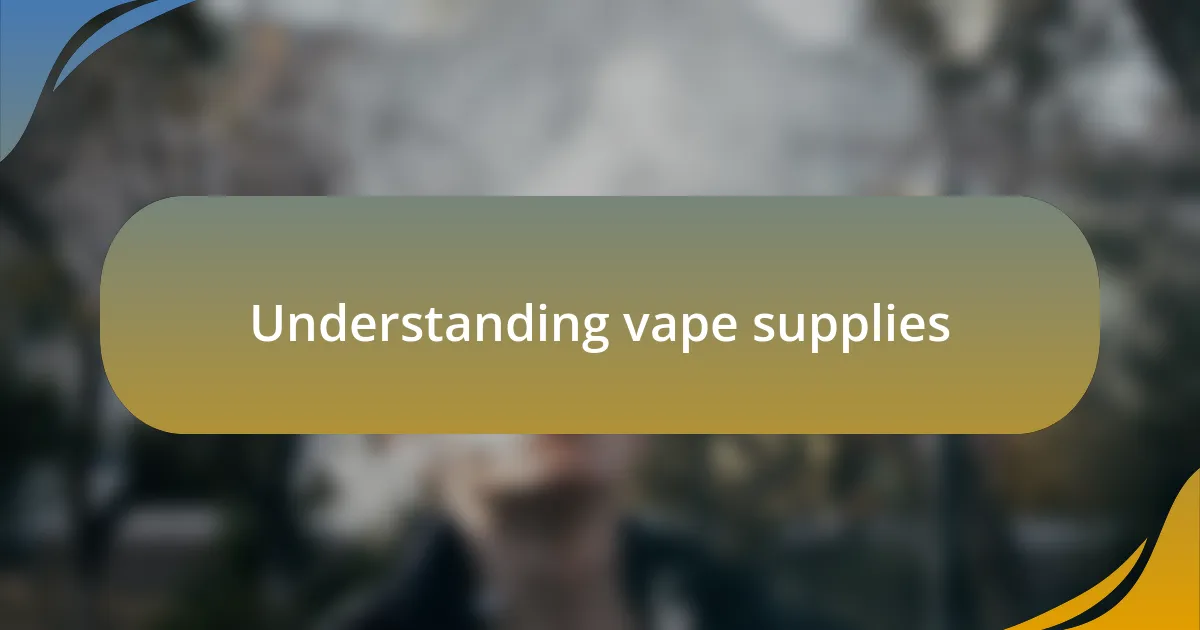
Understanding vape supplies
Vape supplies encompass a variety of items essential for a satisfying vaping experience. From e-liquids to coils and batteries, each element plays a critical role in how the device performs and how the user feels during and after a session. Have you ever noticed how a slight change in your e-liquid flavor can elevate your mood or even alter your creativity level?
Selecting the right vape supplies can feel overwhelming, especially for newcomers. I remember when I first started; I was clueless about what I needed. After some trial and error, I found that investing in high-quality coils made a significant difference in flavor and cloud production. It’s those small changes that often lead to a more enjoyable experience.
I find that understanding vape supplies goes beyond just selection; it’s also about compatibility. If your tank isn’t compatible with your mod, the experience can be frustrating. Think about it: why would anyone want to invest time and money into a device that doesn’t suit their vaping style? Learning how different components interact can mean the difference between a mediocre and an extraordinary vaping experience.
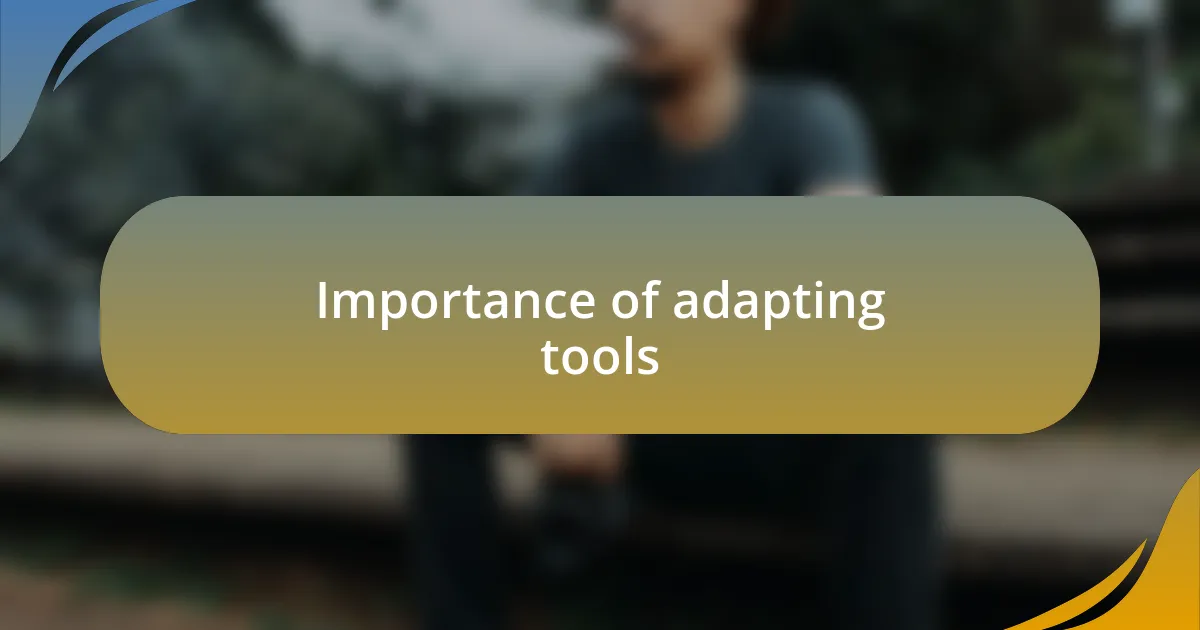
Importance of adapting tools
Adapting tools in the vaping world is crucial for maximizing performance and personal satisfaction. For instance, when I discovered how adjusting the wattage on my device impacted my flavor experience, it was a game-changer. Why settle for average when small modifications can amplify enjoyment?
When I switched to lower-resistance coils, it drastically enhanced the vapor production, creating thicker clouds that truly satisfied my cravings. This adjustment not only made my sessions more enjoyable, but it also made me feel more connected to my gear. Have you ever experienced that rush of excitement when you realize a simple adjustment can transform your entire experience?
Moreover, I’ve learned that being adaptable allows me to keep up with trends and innovations in the vaping community. As new products emerge, my willingness to tweak my tools ensures that I don’t miss out on anything groundbreaking. Isn’t it fascinating how a little flexibility can lead to discovering your favorite new flavors or devices?

Types of tools for vaping
When it comes to vaping, the essential tools are diverse and cater to various preferences. From high-quality box mods that allow for advanced settings to sleek pod systems that offer portability, there’s something for everyone. I remember the first time I tried a sub-ohm tank; the robust flavor and cloud production caught me off guard, making me wonder how I ever vaped without it.
Coils are another critical component worth exploring. With different materials like Kanthal, stainless steel, and Ni80, each brings a unique experience to the table. When I switched to a stainless steel coil, I was taken aback by how quickly it heated up compared to other materials, resulting in an almost instant flavor explosion. Have you considered how the choice of coils might shape your taste adventures?
Lastly, let’s not overlook accessories such as drip tips and tools for maintenance. I genuinely enjoy personalizing my drip tip to match my vibe—it’s a small detail that makes a big difference. Each time I replace a worn O-ring or clean my tank, I’m reminded of the connection I have to my gear, which truly enhances my vaping journey. These seemingly minor adjustments often lead to optimal performance and an overall better experience.
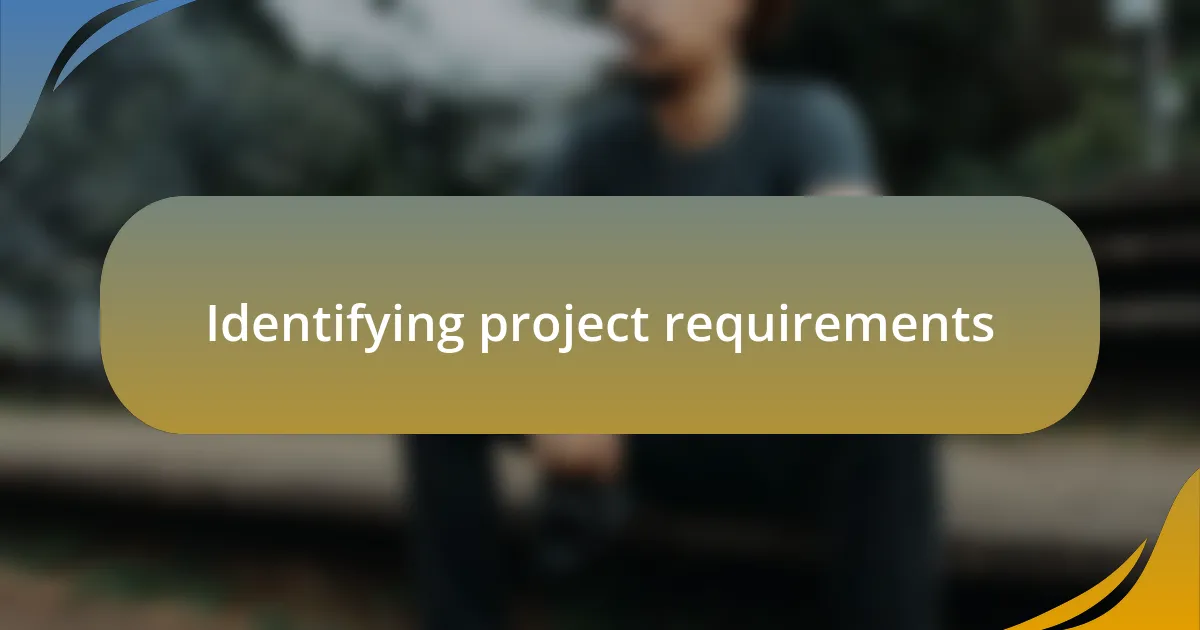
Identifying project requirements
To effectively identify project requirements, I often begin by considering the specific needs of my vaping community. What do they crave? For example, during a recent project focused on developing a new vape flavor, I made a point to run surveys that gauge preferences on sweetness or freshness. Engaging with users through direct feedback ensures that I’m aligned with their expectations.
I also reflect on the practical aspects. I recall one time I was gearing up to launch a limited-edition vape kit, and I realized I hadn’t assessed the packaging requirements properly. This oversight nearly led to delays and unmet customer demand. Have you ever faced a situation where overlooking the smaller details made a significant impact on your project outcome?
Additionally, I find that exploring market trends can reveal hidden requirements I wouldn’t typically consider. In my experience, observing social media hashtags related to vaping has unveiled insights into what features resonate with users. For instance, noticing a surge in interest around eco-friendly materials influenced my decision to switch to sustainable options for my products. This kind of research, combined with community feedback, creates a comprehensive understanding of project needs and ultimately drives success.
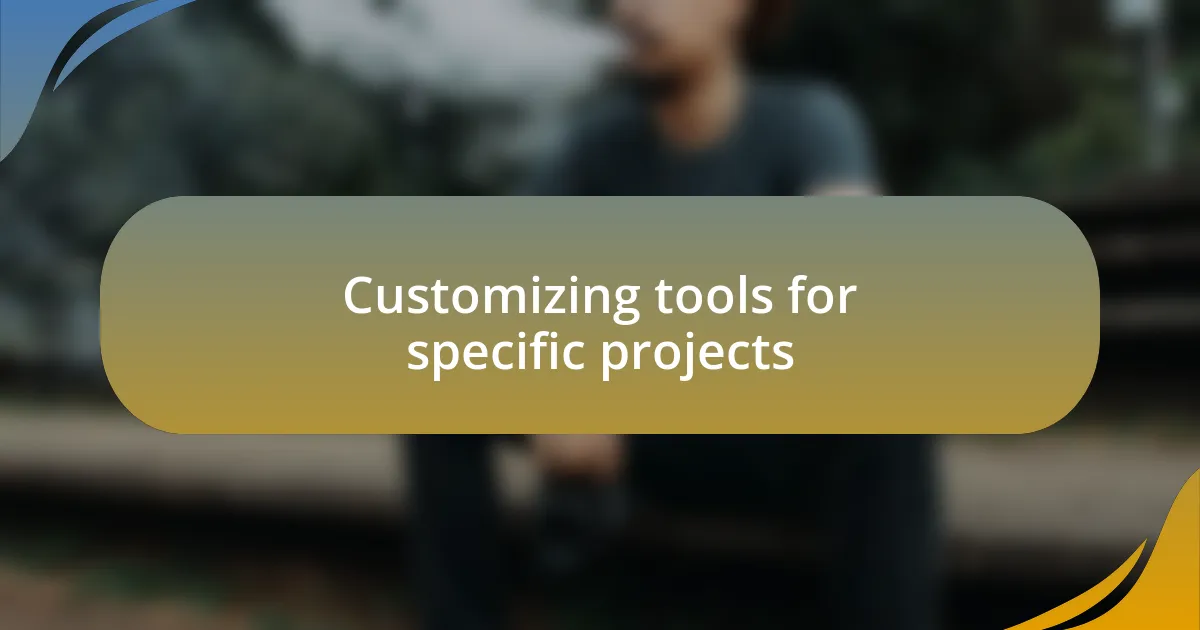
Customizing tools for specific projects
When it comes to customizing tools for specific projects, I find that flexibility is key. For instance, while developing a vape pen designed for beginners, I adapted my user testing tools to include simpler prototypes and clear instructions. It was eye-opening to see how small adjustments in the design led to better understanding and more enthusiastic feedback from novice users. Have you ever noticed how making things more accessible can completely transform user experience?
Communication tools also play a vital role. During a recent project, I tailored my feedback forms to capture specific sentiments about a new e-liquid flavor. Instead of generic questions, I included prompts that resonated with my testers’ preferences, which allowed for deeper insights. It was fascinating to see how these customized tools led to more meaningful responses, enhancing my overall approach.
Then there are the technical aspects that require fine-tuning. While working on a new website feature for product reviews, I chose to integrate analytics tools that offer real-time data on user engagement. This decision stemmed from my belief that understanding visitor behavior could directly influence product development. The result? An informed strategy that not only elevated my offerings but also built stronger connections with my audience. What tools have you customized to elevate your project’s success?

Personal experiences with tool adaptation
When I first started working with vape design, I quickly realized that not all tools fit every project. I remember a time when I was refining a vape mod aimed at advanced users. My initial measurements and specifications were too generic, and I nearly missed pinpointing the nuances that seasoned vapers truly appreciate. By adapting my drafting tools to include more precise metrics, I ended up capturing those critical details that made the mod stand out.
In one particularly memorable project, I had to revamp a packaging tool to fit the unique branding of a new flavor line. I decided to create a mock-up with unconventional materials that better represented the product’s bold character. This adaptation sparked such excitement during team meetings; we all felt it was more than just packaging—it was part of the overall experience we wanted to deliver. Have you ever felt that spark of creativity when using non-traditional materials?
Another instance was while I was developing marketing materials for a limited-edition vape flavor. I modified my graphic design tools to allow for more vivid colors and textures, aligning them with the flavor notes we wanted to portray. This adjustment not only helped grab attention but evoked an emotional response that resonated with consumers. It’s funny how the right tools can transform a concept into something that truly connects with people, isn’t it?
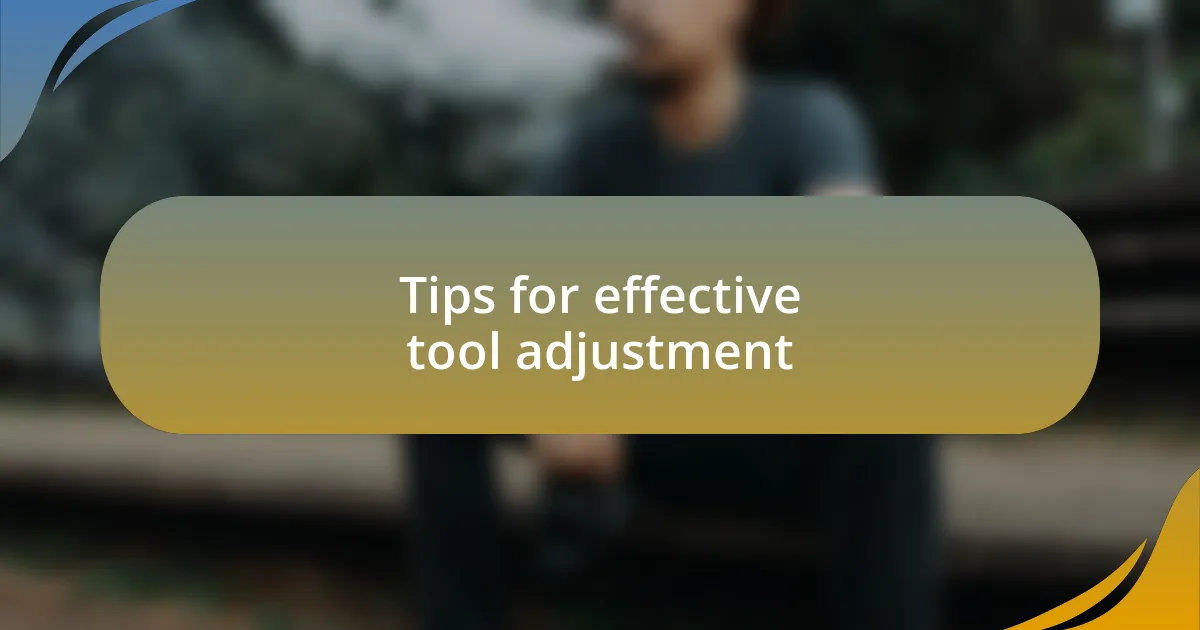
Tips for effective tool adjustment
When adjusting tools, I often find it helpful to remember that flexibility is key. For instance, while developing a new drip tip design, I changed my CAD software settings to prioritize aesthetics without sacrificing functionality. This small tweak not only improved the design process but also encouraged me to think outside the box for future innovations. Have you ever noticed how reconfiguring a small aspect can lead to major breakthroughs?
Another technique that works well for me is seeking feedback throughout the adaptation process. Once, I was enhancing a design for a portable vape charger and reached out to a few friends who are avid users. Their insights prompted me to refine the ergonomic features and make it more user-friendly. Engaging others often leads to unexpected ideas that can elevate a project significantly.
Lastly, I’ve learned that taking a step back can provide clarity. When I was in the middle of redesigning a coil tool, I hit a creative wall. I took a day to step away from the project and then returned with fresh eyes. That time away allowed me to see how I could integrate features I hadn’t considered initially, which ultimately enhanced the tool’s usability. Have you ever found that a break can invigorate your creativity?